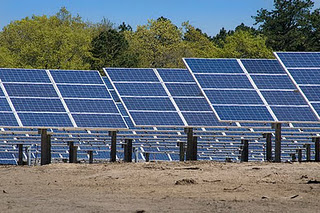
Within a few days, Nick Thiel will take control of about 110,000 high-end solar panels pumping 30 megawatts of power onto the grid from a former potato and carrot farm.
Thiel is operations manager of the San Luis Solar Ranch, a 300-acre facility in the San Luis Valley in southern Colorado, a high-desert area considered ideal for solar power generation. I visited the solar ranch during a week-long expedition of energy-related locations in New Mexico and southern Colorado organized by the Institutes for Journalism & Natural Resources.
The SunPower solar panels, which cover 220 acres themselves, are expected to be “energized” this week and the plant officially commissioned by operator Iberdrola Renewables next month. Utility Xcel Energy, which is purchasing the power from the farm, estimates it will supply about 7,500 homes during peak times.
Bringing the plant online is a significant change for the San Luis Valley since the Iberdola plant is substantially larger than the two other plants in the basin, which are both under 10 megawatts. Area officials are eager to bring in more solar power because it can bring badly needed income, but at least one project was defeated by local activists due to concerns over water and land use.
For Thiel individually, though, the $100 million plant comes with a heavy responsibility as only he and one technician will operate the plant from a small office a few hundreds yards from the panels. His main tool in monitoring the entire system is a computer back in the office hooked up to a network of sensors in the field.
All of the hardware is instrumented, including the transformers, inverters, and motors that tilt the panels to face the sun over the course of the day. Those thousands of sensors create a flow of information back to a custom application used to monitor and troubleshoot problems.
If one row of panels isn’t producing the same amount of power as another, it could be a sign that there’s a broken piece of equipment or disconnected cable. The software also tracks the temperature of transformers to ensure they’re not overheating or help schedule maintenance.
Having worked on wind turbines, which have many more moving parts, Thiel expects monitoring the solar farm to be relatively quiet. But if there is a technical problem, he’ll automatically receive an e-mail or text alert.
“My biggest concern is the weather, but we’re taking precautions with the [meteorological] tower and our national control center,” he said, adding that lightning and high winds can create hazards. At his former job, a tornado came within a few miles of a giant wind farm, which could have caused substantial damage.
If a storm with high winds kicks into the valley, the panels’ tracking system is supposed to set the panels in a safer, horizontal position. But the solar farm also has a meteorological station to monitor wind speed and other weather data to give plant operators early warnings.
Iberdrola Renewables operates a national control center where technicians can remotely monitor wind and solar farms, including the potential impact of weather. In his previous job, the national center warned wind turbine technicians of the potential lightning strikes while technicians were working inside a turbine.
For Thiel, though, his best chance at spotting a problem will be keeping an eye on the software, which provides a graphical view of the plant and lets him drill down to troubleshoot. Given that taking the panels offline costs his company money, he expects to be making most of his maintenance repairs at night.
Source: cnet
 Follow
Follow